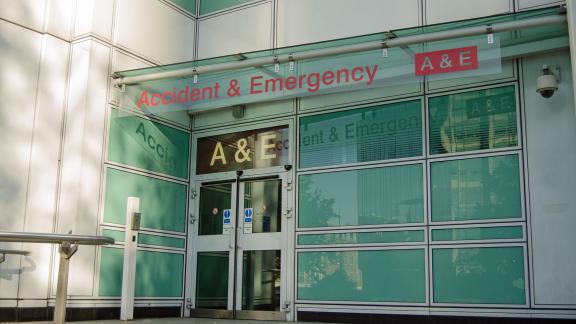Analysis: October release of NHS performance statistics

At a glance
- The NHS is delivering high levels of elective care and diagnostics. In October, the number of people seen by a consultant for the first time for cancer was higher than before the pandemic and the fifth most in an individual month ever.
- At the same time, the health system is seeing very high levels of demand. The acute sector, for example, is seeing record numbers of the most urgent A&E attendances, and primary care is seeing rising demand for GPs, the front door of the health service.
- This is in the context of additional pressures due to rising COVID-19 rates and risk of influenza infections. The UK has reported 223 COVID-19 deaths recorded within 28 days of a positive test - the highest for seven months. The seven-day average for COVID-19 cases stands at 44,145 a day.
- The health and care workforce is braced to respond to these pressures as the country moves from autumn to winter, but there are challenges ahead to ensure the health service has the numbers to deliver what is required.
Activity
Electives
The NHS is continuing to ramp up elective activity, with NHS staff working tirelessly to clear the backlog of care and treatment that built up over the pandemic. 1,059,214 waiting periods in total were ended or had their ‘clock’ stopped in August; either via inpatient admission or non-admitted pathways like outpatients (plus a smaller number of cases where there was a decision not to proceed with further treatment).
This is down from 1.26 million in July and also behind August 2019, when there were 1.28 million clock stops. However, this represents a huge achievement at a time when capacity has been limited by infection control measures. Our members are reporting bed occupancy at over 90 per cent.
Cancer
Over 210,000 people were seen by a consultant for the first time for cancer nationally following an urgent GP referral in August 2021, higher than a pre-pandemic comparison (for instance, August 2019 saw 200,000 checks). This month, 84.7 per cent of patients were seen within two weeks. These are historically high numbers of checks, with the highest number since records began being June 2021, at 230,000. This is the fifth most in an individual month ever.
11,179 patients with breast symptoms (where cancer is not suspected) were seen by a consultant in August, 79.1 per cent were seen within two weeks. This is up from 62.1 per cent earlier in 2021 and moves the service closer to the 93 per cent operational standard that it strives for as it recovers.
Challenges
Waiting lists
The waiting list for elective procedures continues to grow, rising to 5.72 million in August’s data from a previous high of 5.61 million patients in July.
There were 1.47 million new referral-to-treatment (RTT) periods (people joining the waiting list) in August. This is still trending below pre-pandemic levels – across 2019 the average new referral-to-treatment periods was 1.68 million. This figure is also down from just over 1.6 million in the previous month.
Around 7 million ‘missing’ patients who did not present for treatment during the pandemic and these figures suggest that they are still not yet seeking care. As such, the numbers above represent only the ‘official’ waiting list. Read more in our Building Back Inclusively briefing.
A similar picture can be seen with GP referrals. There were 934,000 GP referrals for first consultant-led outpatient appointments in August, although this had risen to over 1 million in June and July. Nevertheless, this is an achievement considering that primary care has built back capacity from an average of 420,000 referrals a month across the first quarter of 2020/21.
In general, this has been a busy time for primary care, with GP practices at the forefront of the NHS’s response to the pandemic. Including COVID-19 appointments, the overall appointment count for August 2021 is still two million higher than pre-pandemic levels (August 2019).
Long waiters
Of the patients already waiting, the number of 104-week waiters has risen to 9,754 and the number of 52-week waiters is now 292,138. The 52-week wait figure is down 0.3 per cent from 293,102 in the previous month’s figures, while the 104-week wait figure is up from 7,980 in July.
The slight decrease in patients tipping over 52 weeks is unsurprising; the amount of clock starts in the summer 2020 was much lower than a typical month (either now, or pre-pandemic). However, the 104-week figures are historically high. Prior to 2020, the number of patients waiting over 52 weeks had not been above 7,000 since November 2011, and we now have 9,754 waiting over 104 weeks, with over 5,000 more patients about to reach this figure (100-104 week waiters).
This is of particular note in the context of the recently published H2 planning guidance, which asks systems to “eliminate waits of over 104 weeks by March 2022” and “hold or where possible reduce the number of patients waiting over 52 weeks”.
To eliminate waits of over 104 weeks by the end of March, over 150,000 patients waiting between 74 and 104 weeks in the latest data will need to have been treated, a significant challenge. Our members have told us of potential prioritisation challenges as we head into winter; you can read more on what the H2 planning guidance means for the elective recovery.
A&E
In addition to delivering additional elective care, the NHS has been dealing with unprecedented demand in emergency departments since this summer, with record type 1 attendances* (June was the highest figure since records began, at 1.44 million). The figure of 1.39 million type 1 attendances in September is more than the same month in 2018 (1.27 million) and 2019 (1.34 million) and at a time when the NHS is under added stress, including the need for infection control measures.
*Type 1 attendances are at major emergency departments. These are consultant led 24-hour services with full resuscitation capability.
This challenging picture is further evidenced by the considerable four-hour+ waits from decision to admit to admission, with a record 104,875 patients waiting more than four hours in September and over 5,000 patients waiting more than 12 hours for the first time since records began.
Ambulance
The latest figures show a continuation of record pressures on the ambulance service. In September, there were 946,707 calls answered by the ambulance service, well above the numbers in previous years and up more than 20,000 from August. In September 2019, this figure was comparatively much lower at just over 739,000.
Workforce
While the NHS faces winter pressures every year, 2021 is a uniquely difficult year as demonstrated by the demand pressures shown above. This is compounded by workforce challenges.
As shown in the data below, every region in England has experienced an uptick in vacancies over the first quarter in 2021/22. Although quarter 1 tends to show a slight increase as trusts review their staffing for the year ahead, these figures are something to keep a close eye on as concerns about staff burnout and postponed retirements have been regularly flagged by our members.
Pressure point: care home workforce
Alongside concerns about the NHS workforce, warnings about the dire situation in social care were highlighted by care leaders in early October. The latest Skills for Care report showed 105,000 vacancies in the adult social care sector being advertised on an average day in 20/21 – more than before COVID-19 – alongside a fear from care leaders that this could get worse due to the mandatory vaccination policy.
Data from NHS England in September – eight weeks ahead of the 11 November deadline when all workers in care homes in England must be vaccinated unless exempt – showed over 40,000 staff from adult and young persons care homes had not had their first vaccination; a concern ahead of the 11 November deadline.
With huge challenges around bed occupancy and NHS resource already, being unable to discharge medically fit patients could be an extra source of pressure on the NHS.
How is the NHS performing?
View our analysis of the latest NHS performance figures for a rounded view of how healthcare services are coping under immense pressure.



